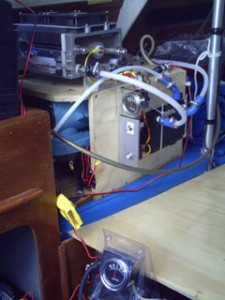We sailed to Goldstream in the fall of 2007, in the sloop “Jim D”, which was assisted with a Horizon H300 fuel cell. After an evaluation of the trip, we estimated that the electric motor powering the boat needed to be in the range of 2 to 4 horsepower. As off the shelf solutions were not immediately evident, the plan to modify a Yamaha motor from gas to electric was conceived. Gas to Electric Outboard Demo Video. The design was based on available technologies that were easily combined and affordable. The first system was deployed in early June on Ian Soutar’s 18-foot cabin cruiser, “Pepper Pot”. It was on display with the sloop “Jim D” at the Tall Ship Festival in Victoria. The “Jim D” had been fitted with a Minn Kota, model RT202/EM, a 4 horsepower dual electric motor system capable of producing over 200 pounds of thrust. This was a 36 VDC, 98-amp unit that required an even larger fuel cell system than we had originally planned.
YouTube Video
In an attempt to accelerate our development plan, we became involved with the Mechatronics program at the University of Victoria. A group of 5 fourth year mechanical and electrical engineering students undertook the development of a dual 1.2-kilowatt fuel cell system along with finalizing the Yamaha conversion kit. In mid August, a working prototype was ready for deployment. The resulting architecture was even better than we had expected, allowing the operation of up to 4 parallel fuel stacks by one master controller. This would allow for redundancy in the system and permit up to 4.8-kilowatts of power at a much reduced cost.
While the pair of 1.2-kilowatt fuel cells were being worked on at the University and using the B.C government carbon tax refund, the boat was outfitted with 35 watts of Canadian Tire solar panels. They provided sufficient power for local operations of the Jim D on a daily basis. During this period of testing, it was found that only one of the RT202/EM motors was required for the boat to reach a maximum speed of 4 miles per hour, the speed being limited by the 4-inch pitch of the propeller. It was also established that only 550 to 600 watts of power was required to maintain this speed for extended periods of time. As a result, the fuel cell system was trimmed back to a single Palcan PC5, 1.2-kilowatt fuel cell stack.
September and October has seen continued testing of the combination fuel cell/solar power system with very satisfactory results. My appreciation to Palcan for all of their technical assistance and to the Selkirk Station Kayak and Bike for supplying hydrogen this year.
In May of this year, I purchased 40 litres of gasoline for the sailboat and after some 150 miles and 5 months of use, I still have about 30 to 35 litres left. The gasoline is used as ballast to help keep the electric motor portion of the gas/ electric hybrid outboard motor under the surface of the water. The other benefit of using only one of the electric motors is that the weight reduction has made it easer to manually lift the outboard into its normal out of water storage position.
As a result of seeing the news stories about Canada’s first fuel cell assisted sailboat, theAlumni Association of Loyalist College, Belleville Ontario has nominated me for this year’sOntario Premiers Award for Technology. I will also receive the “Best Innovation Award” from the Esquimalt Chamber of Commerce at the Annual General Meeting, November 19, 2008. I wish to thank those involved for these honors.




